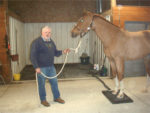Advertise Follow Us
Equipment
Tool Use
Time is money, so waiting for an inefficient forge to heat horseshoes adequately can hit you right in the wallet. Prevent that from happening with this step-by-step process
Read More
Product Focus
Get Your Tools Off The Ground
Regardless of the style of toolbox you use, organization is the key to being efficient and safe
Read More
Product Focus
Watch Your Back
If your toolbox is not both farrier and horse friendly, it’s not doing the job you need it to do
Read More
Product Knowledge
Unsticking the Doubts About Hoof Adhesives
Knowing the properties of the available glues can help farriers make the right choices for effective, lasting glue-on shoes and hoof repairs
Read More
Farrier Innovations
A Blow Dryer for the Hoof
Hoof Doc system useful for quick drying of hooves as well as long-term maintenance of moisture content
Read More
Product Knowledge
Farrier-Developed Software Records Visual Documentation
Photo histories become convenient, video can be slowed to reveal gait problems to the human eye, helping farriers gain owners’ support as horses grow sounder
Read More
Tool Use
Underused Hoof Gauge Can Boost A Farrier’s Success
This low-tech tool offers an edge when it’s time to assess a hoof and determine the work to be done
Read More
Step On It!
High-tech pressure mat system gives this Texas veterinarian new information for evaluating and tailoring shoeing
Read More











